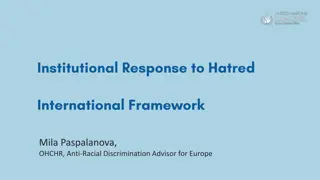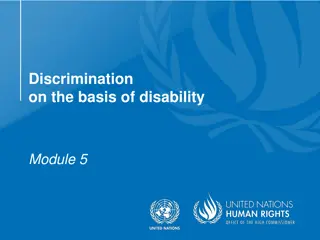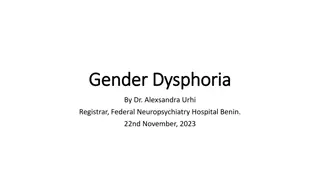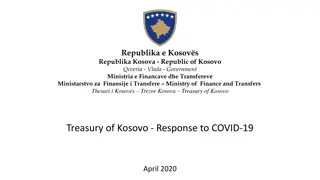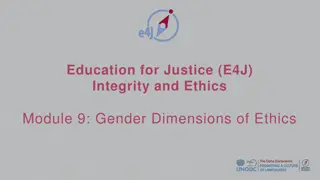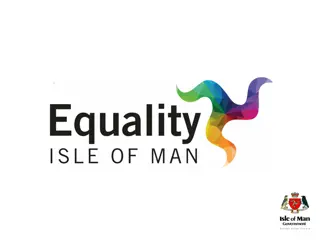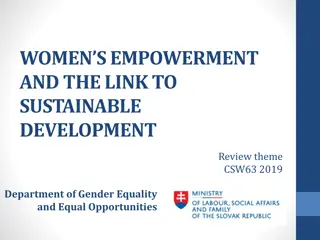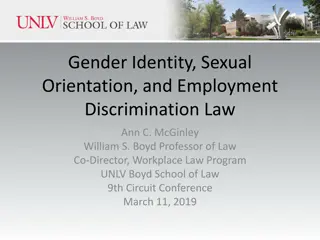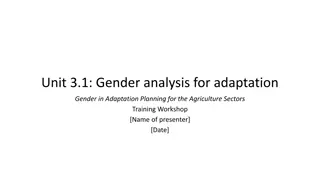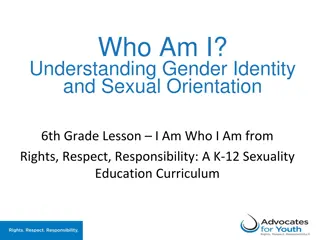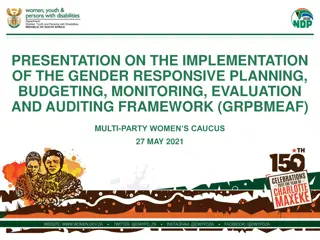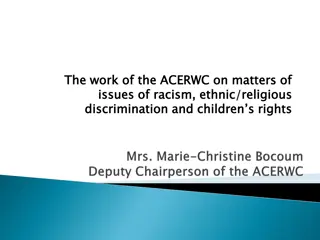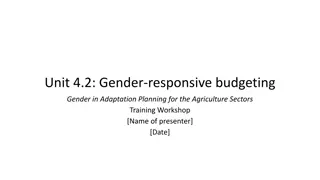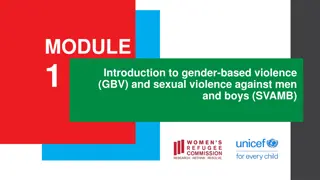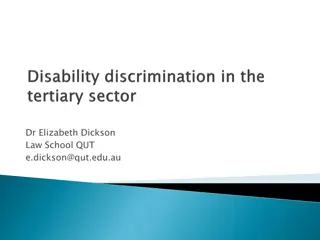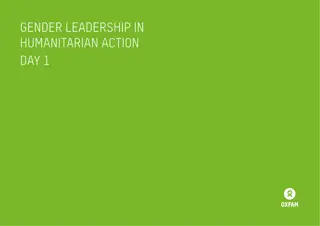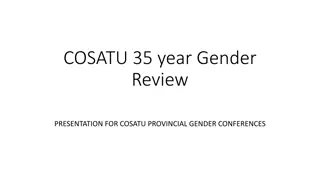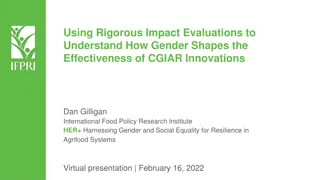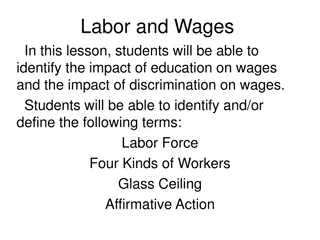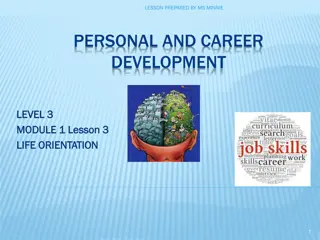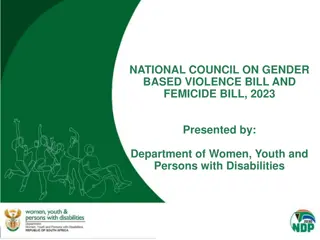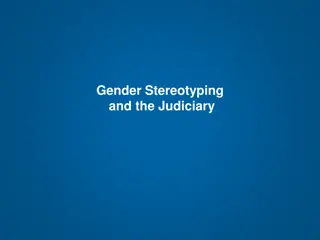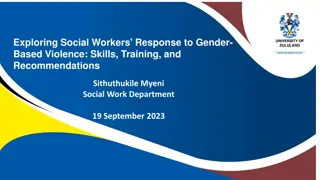Gender-based Discrimination in Kosovo: Research Findings and Analysis
Research conducted in Kosovo evaluates gender-based discrimination awareness and implementation of legal responsibilities. The study assesses the legal framework, reported cases, public awareness, and institutional response to discrimination. Methodologies included legal analysis, surveys, interviews, and an examination of gender-disaggregated data, shedding light on the prevalence and treatment of gender-based discrimination in the region.
Download Presentation

Please find below an Image/Link to download the presentation.
The content on the website is provided AS IS for your information and personal use only. It may not be sold, licensed, or shared on other websites without obtaining consent from the author. Download presentation by click this link. If you encounter any issues during the download, it is possible that the publisher has removed the file from their server.
E N D
Presentation Transcript
Co-funded by Sweden/Sida Funded by the European Union Gender-based Discrimination and Labour in Kosovo Second Edition By Iliriana Banjska, David JJ Ryan, Endrita Banjska, Nicole Farnsworth, Lirika Demiri, Liridona Sijarina, Adelina T rshani, Rita Berisha, and Besarta Breznica Implemented by:
Research Aims Assess the extent of and any changes in awareness related to gender-based discrimination among people and institutions since 2017 (2018-2020) Assess the extent to which institutions are implementing their legal responsibilities related to addressing gender- based discrimination in labour and safeguarding women s labour rights.
Research Questions To what extent is the legal framework relating to gender-based discrimination complete in accordance with relevant EU directives and protections? How many work-related gender-based discrimination cases have been reported to different institutions in 2008-2020? For what reasons have few discrimination cases been reported? To what extent are people aware of various forms of discrimination and how to report them; how has this awareness changed over time? How have relevant institutions treated discrimination cases to date; how has this changed over time, if at all?
Methodology: Mixed Methods Legal analysis Desk research Survey Official requests for gender-disaggregated data In-depth interviews with 94 officials from institutions that have a legal responsibility for addressing gender-based discrimination, and with CSO representatives
Methodology: Different Methods Survey with 5,778 participants (women and men); 681 completed approximately 90% of the survey (75% women, 25% men). Limitations: Not generalisable because it did not involve random sampling Conclusions thus refer to the sample and not the Kosovo population Oversampled educated, urban-dwellers, women Hypothesise the situation could be worse for others Despite limitations, research provides substantial qualitative evidence of widespread gender-based discrimination.
Co-funded by Sweden/Sida Funded by the European Union The Legal Framework Implemented by:
Legal Framework Constitution (Chapters II and III) International instruments (Constitution, Art. 22, as amended) Criminal Code (e.g. Arts. 183 and Chapter XIX) Legislation: Law No. 03/L-212 on Labour ( LL ) Law No. 05/L-021 on Protection from Discrimination ( LPD ), and Law No. 05/L-020 on Gender Equality ( LGE )
Discrimination in Law Protected grounds include: Gender/sex (Constitution; LL; LPD; LGE) Family/marital status (LL; LPD; LGE) Parenting (LGE) Pregnancy/maternity (LPD; LGE) Forms of discrimination include: Direct and indirect discrimination (LPD; LGE) Harassment (LPD; LGE) Sexual harassment (Criminal Code; LPD; LGE) Victimisation (LPD; LGE)
Overlap in Scope Law on Labour Recruitment, promotion, training, terms and conditions of employment, disciplinary measures, cancellation of the employment contract or other matters arising out of employment relationships. (LL, Art. 5.1) Law on Protection from Discrimination Access to employment, self employment, promotion, vocational training, working conditions, termination, pay, membership of workers organisations. (LPD, Art. 2.1) Law on Gender Equality Access to employment, self employment, promotion, vocational training, working conditions, termination, pay, membership of workers organisations. (LGE, Art. 15.1)
Overlap in Sanctions Law on Labour 100 10,000 for each violation of the provision of ... the prohibition of all forms of discrimination . (Administrative Instruction No. 07/2012, Art. 7.5.2) Law on Protection from Discrimination 1050 1,350 for a legal entity. (LPD, Art. 23.2) Law on Gender Equality 700 900 for a legal entity. (LGE, Art. 23.4)
Good Practices for Harmonisation Laws containing provisions relating to the prevention and protection against discrimination shall be harmonized with this Law [on Protection from Discrimination] within two years from the date of entry into force of this Law. (North Macedonia, LPD No. 258/2020, Art. 48) Provisions on minor offences, which are not in accordance with this law, shall be brought into compliance within one (1) year from the day when this law enters into force. (Law on Minor Offences N . 05/L 087, Art. 167)
Labour Rights: Leave Kosovo should reform the system of maternity and parental leave, which presents an obstacle to the hiring of women, particularly in the private sector. (European Commission, 2019) Limited access to childcare and flexible working arrangements, as well as regulations which discourage the recruitment of women (e.g. lengthy maternity leave) remain important barriers. (European Commission, 2021)
Labour Rights: Leave Increase paternity leave (min. 10 days). Provide parental leave for all parents (min. 4 months). Ensure high wage replacement rates to achieve uptake amongst men. Introduce the right to carers leave (min. 5 days). Develop flexible working arrangements for parents and carers. (Work-Life Balance Directive, Arts. 4 - 6 and 9)
Labour Rights: Contracts Measures are required to prevent abuse arising from the use of successive fixed-term employment contracts, e.g.: Require objective reasons for any fixed-term appointment. Reduce the time period to become a permanent employee. Ensure temporary incapacity (e.g. pregnancy, maternity or parental leave) does not interrupt the calculation of the period to become a permanent employee. Ensure successive contracts are considered cumulatively in calculating qualifying period for labour rights. Prevent short gaps between fixed-term appointments being used to circumvent employees becoming permanent.
Gap between Approximation and Implementation Implementation the Law on protection from discrimination is broadly in line with European and international standards, but its implementation remains limited. (European Commission, 2021) Kosovo should in particular ... strengthen the implementation of the Law on Gender Equality. (European Commission, 2021) both rule of law institutions and victims have difficulties in identifying situations in which [the LPD s] provisions can be applied. (European Commission, 2019 and 2020)
Implementation Specialised anti-discrimination training for judges and prosecutors. Specialised training in a broader context for groups that play a role in protection from discrimination. Improving data collection procedures. Ongoing education and public awareness on equal treatment.
Conclusion Harmonisation of the domestic discrimination legal framework is needed to remove overlap and conflict between instruments. The EU Work-Life Balance Directive should be transposed to improve the rights of parents and carers. Amendment is needed to reduce the risk of abuse of successive fixed- term contracts. A gap between approximation and implementation remains.
Co-funded by Sweden/Sida Funded by the European Union Awareness and Reporting of Gender-based Discrimination Implemented by:
Awareness Is discriminating against someone at work because they are a woman or a man illegal?
Awareness and Reporting To which institutions should gender-based discrimination be reported?
Reporting Gender-based Discrimination To which institutions did respondents report gender- based discrimination?
Reporting Gender-based Discrimination Why didn t respondents report sexual harassment?
I have seen several cases when my superior sexually harassed workers. I am aware of all cases, but they are reluctant to tell because they are married, and they are afraid that it will get worse. Discrimination is happening everywhere, but people do not report it. They sacrifice everything for their jobs. - Woman police officer, Ferizaj/Uro evac, 2018 - Man, Gjilan/Gnjilane, 2021
Prevalence of Discrimination In 2018, 28% of surveyed women and 11% of men said they experienced discrimination based on their gender. In 2021, 23% of women and 12% of men said they experienced this. Gender remained the strongest predictor for a person to face discrimination: women are two times more likely than men to suffer discrimination. Discrimination has occurred in both the private sector and in the public administration and government.
Discrimination based on Specific Protected Grounds Gender-based discrimination against persons with different abilities Very few people with different abilities are employed, particularly women Against LGBTIQ+ persons The pandemic was an opportunity to get rid of the few LGBTQ+ people that were employed Against minority ethnic groups Multiple and intersectional discrimination, especially for Roma, Ashkali and Egyptian women People are not allowed to talk about their sexual orientation; they are rejected by society. Imagine their position when it comes to employment. - CSO representative, North Mitrovic /Mitrovica, 2018
Co-funded by Sweden/Sida Funded by the European Union Forms of Gender-based Discrimination Implemented by:
Discrimination in Hiring Approximately one in four surveyed women who attended job interviews believed they were not hired because of their gender. For men, 16% in 2018 and 21% in 2021 In an interview for a job, I was about six months along in my pregnancy, and they automatically took me off the list of people who they would call in interviews. - Woman survey respondent, 2021 Women faced more questions relating to their marital status, children or related plans
Discrimination in Promotion In 2018, 45% of women and 40% of men believed they were not promoted because of their gender. In 2021, this decreased to 22% of women and 14% of men. Due to the pandemic, it is difficult to assess whether there was a decrease in discrimination in promotion, or that promotions were less accessible because private companies, public institutions and CSOs were adapting to the new situation.
Violations of Contracts A slightly higher percentage of women (26% in 2018 and 15% in 2021) had worked without contracts than men (22%, 12%) They told me that women are not capable to do [computer] programming. Me and another colleague [a woman] did not receive any pay. He [the Director] gave us his kids to look after in the software company. He obligated us to do the dishes of the men [that worked in the company] because we are women, and we should keep the space clean. - Woman survey respondent, 2021
Right to Equal Pay for Equal Work Agency for Gender Equality: on average men earn approximately 34 net more than women each month. On average, women earned 312 net, while men earned 346 net a month
Violations of Pregnancy and Maternity Leave Rights In 2018, 28% of employed women were pregnant at one point, in 2021, 13% were pregnant while employed in the last three years. Of them, 26% in 2018 and 14% in 2021 said they were denied their right to paid maternity leave; they were neither paid, nor received government compensation. Of 245 women who took maternity leave in 2018 , 83% returned to their previous place of employment after their leave; in 2021, 78% of the 58 women who took leave returned to their workplace. 21% of these women in 2018 and 26% in 2021 indicated that they were pressured to return to work earlier than planned.
Violations of Rights to Paternity Leave Of the new fathers surveyed, 59% in 2018 and 65% in 2021 said that their employer allowed them to take 1-3 days off, while 25% had 4-10 days. Very few men reported that they were treated differently when returning from leave (only 2% in 2018 and none in 2021) In the 2018 survey, approximately 11% of new fathers had not received any days off. In 2021, this increased to 19% of employed fathers. This constitutes a violation of the Labour Law, which foresees at least 2-3 days leave for new fathers.
Sexual Harassment at Work Respondents experiences with sexual harassment at work
Sexual Harassment at Work Most survey respondents in 2018 said persons in higher positions harassed them (75% of women, 56% of men). In 2021, most respondents similarly were harassed by persons in higher positions (72% of women and 61% of men).
Reporting Sexual Harassment To whom did respondents report sexual harassment?
Co-funded by Sweden/Sida Funded by the European Union Institutional Response Implemented by:
Institutional Response Prosecution & Courts Very knowledgeable Few cases reported Did not identify sexual harassment as a form of gender- based discrimination Few to no cases Lack practical and detailed knowledge of legal framework Lack judicial practice Slow treatment of cases Ombudsperson Institution Police
Response to Gender-based Discrimination at Work Civil Society Organisations Labour Inspectorate Labour Unions Increased awareness on gender-based discrimination and how to refer cases. First responders amid COVID-19 labour rights violations Offered free legal aid and counselling to women. Monitored cases in courts. Undertook awareness-raising Advocated legal amendments and improved implementation Seem informed on legal framework Still few cases reported, though data is inadequate Some inspectors made victim-blaming comments Recognise their role, Active in asking employees to use their reporting channels Still few cases May not understand what gender-based discrimination entails
Co-funded by Sweden/Sida Funded by the European Union RECOMMENDATIONS Implemented by:
For the Ministry of Finance, Labour and Transfers Urgently amend and finalize the Law on Labour to align it with the EU Work-Life Balance Directive and to address other shortcomings. Ensure adequate consultation with civil society Ensure sufficient budget allocations are made to finance leaves, based on gender analysis and gender-responsive budgeting.
For All Responsible Institutions Improve data collection and management, ensuring all electronically managed data is disaggregated by: Gender of victim(s) and alleged perpetrator(s) Location (e.g., work, home, public space) Form of discrimination (LGE). Regularly publish summary data. Improve inter-institutional awareness-raising and cooperation (e.g., best practice in Albania). Ensure obligatory, institutionalised training for responsible officials on: Gender equality and transforming gender norms Legal framework on gender-based discrimination at work and appropriate referrals Forms of gender-based discrimination, esp. sexual harassment (Criminal Code definition)
For the Kosovo Police Improve data management. Include in obligatory police training information on the legal framework on gender-based discrimination at work, focusing on sexual harassment as a crime, as per the new Criminal Code definition.
For the Prosecution Update the SMIL database to collect and manage data disaggregated by gender and location. Ensure all prosecutors undergo training on gender equality and the new Criminal Code definition of sexual harassment. Consider designating specialised prosecutors, well-trained in prosecuting gender-based crimes.
For the Labour Inspectorate Improve data management systems: complaints received, inspections undertaken, disciplinary measures initiated, disaggregated by gender and relevant laws breached. In hiring more inspectors, seek to ensure a gender balance by using affirmative measures, in accordance with the LGE. Institutionalise regular training for all inspectors on gender equality, gender- based discrimination at work, and their role in treating it.
For the Ombudsperson Institution Finish revising the OI database, including gender-disaggregated data and marking cases involving gender-based discrimination at work. Consider ensuring that women representatives of the OI are available to meet women who have suffered gender-based discrimination. Ensure all OI offices have confidential spaces available for OI representatives to meet women and other actors. In close cooperation with CSOs, the Labour Inspectorate and labour unions, organise regular awareness-raising campaigns on gender- based discrimination towards increasing citizens knowledge of what it entails, how they can file claims, and what support the OI can provide.
For Labour Unions Collect data on gender-based discrimination cases by gender and violation. Ensure policies against gender-based discrimination and equal opportunities are in place and implemented. Provide further training for all union representatives on the relevant legal framework on gender-based discrimination at work and how to report it. Launch outreach campaigns to inform workers about the legal framework on gender-based discrimination and labour. Continue collaborating with experienced WCSOs for more effective outreach, targeting women. Improve people s awareness and trust in unions, including how unions can support persons who have experienced gender-based discrimination at work. Improve women s participation in unions. Monitor the work of the Labour Inspectorate to verify if gender-based discrimination at work is being addressed correctly.
For Civil Society Organizations Continue collaborating through a diverse network of CSOs involved in anti-discrimination activities, including joint advocacy for needed legal changes and their implementation. Continue organising awareness-raising campaigns to increase women s and men s knowledge about gender-based discrimination in labour and where to report it. Specifically target people from minority ethnic groups, LGBTIQ+ persons and persons with different abilities with information about their rights; support them in reporting and seeking justice for gender-based discrimination.
For the European Union Continue to encourage the government to expedite legal amendments and reforms in line with the EU Work-Life Directive and to implement the legal framework on gender-based discrimination through: Kosovo Report (Ch. 19) Political Dialogue Cooperation programming (continue to ask contractors to further gender equality in their support of reforms) Continued cooperation, support, and dialogue with WCSOs.
Co-funded by the European Union Co-funded by Sweden/Sida Implemented by:
Co-funded by Sweden/Sida Funded by the European Union Gender-based Discrimination and Labour in Kosovo Second Edition By Iliriana Banjska, David JJ Ryan, Endrita Banjska, Nicole Farnsworth, Lirika Demiri, Liridona Sijarina, Adelina T rshani, Rita Berisha, and Besarta Breznica Implemented by:









